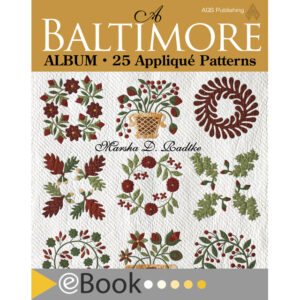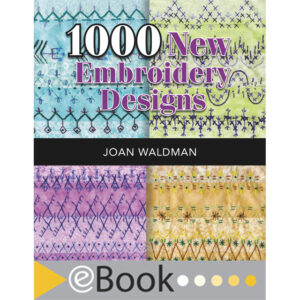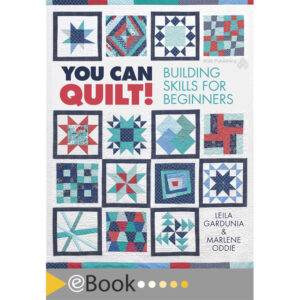At American Quilter’s Society, we’ve always got an eye on quilting trends. From innovative techniques to returning classics, there’s a trend for everyone. This month, we’re trying Hand Piecing.

Hand piecing is how quilters made quilts through the ages until the invention of the sewing machine in the mid-1800s. To this day, it remains one of the most versatile, transportable, and relaxing ways to piece a quilt. With very few tools required, it is also one of the easiest techniques to try.
How to Try This Trend
Hand Piecing Supplies

Essentials:
You will want all of these supplies, but there are a range of options.
- Fabric – Any quilting weight cotton is excellent for sewing by hand.
- Needles – Sharps are commonly used in piecing. Sharp needles are medium in length, slim, and as the name says, sharp. Pick up a variety pack and try different sizes to find what best suits you. Once you find a size you like, buy packs in that size. The heat of your hand and the pressure of sewing bends needles over time, so replacing them as they warp is one thing you can do to make piecing stress-free.
- Thread – 50wt Cotton is excellent for hand piecing and keeping neutral colors (e.g. black, white, cream, taupe, and gray) on hand will cover your needs for most any project.
- Scissors – Karen K. Buckley Perfect Purple 7 1/2″ Scissors can do it all, gripping fabric as it cuts for accurate cutting.
- Pencil with soft lead – Sewline Trio Colors Fabric Pencil is the only pencil you need to mark any color fabric.
- Ruler – Add-A-Quarter or a Quilter’s Select 2″ x 8″ Non-Slip Ruler are great options. Just use something that is easy to pack.
Luxuries:
You may want some or all of these supplies, but you might find they are unnecessary to you.
- Thimble – This is arguably an essential, but not everyone likes or uses thimbles for piecing. Thimbles come in all shapes and sizes and are made from all kinds of materials. Choose a thimble that fits comfortably on the middle or index finger of your dominant hand. Metal thimbles last the longest (potentially your entire quilting career!) but leather or other softer thimbles may bring you more comfort while sewing. Most thimbles run a few dollars, so if one isn’t working for you, try a different kind until you find what you like.
- Needle Threader – There are many varieties, but they all help thread needles.
- Magnifier/Reading Glasses & Light – Reducing eyestrain by stitching in excellent light is wise for every stitcher. If you have any trouble seeing the project, use reading glasses or a magnifying glass. Taking care of your body’s needs while sewing helps you and your project.
- Thread Conditioner – Thread conditioner made from wax or synthetic polymer reduces friction and tangling. Using a shorter length of thread typically addresses both problems, but certain threads and situations benefit hugely from using thread conditioner.
- Small Scissors – A small pair of scissors or other type of thread cutter (nail trimmers are a great alternative) are handy for taking your sewing on the go.
- Seam Presser – This tool looks like a very miniature pastry roller. Finger pressing is common in hand piecing, and requires only fingers, but a seam presser tool accomplishes the same task without rubbing oils from your hands into the fabric, using pressure instead of heat to temporarily set a seam.
- Double-Sided Tape – When cutting using templates, a little double-sided tape can take the hassle out of keeping a template from shifting during the tracing process.
Let’s Piece a Block

For this tutorial, we’ll piece the Connecticut state block from Quilt Across the US with AQS
Click Here to download the templates.
The templates are for Foundation Paper Piecing, but we can easily turn them into hand piecing templates but cutting the pattern apart on the solid lines using some paper scissors.
Click Here for a tutorial on turning FPP patterns into template pieces.
Template Cutting
Place the template on the wrong side of the fabric. Use some double-sided tape to stop the template from shifting. Trace 1/4″ around the template using a ruler and a soft-leaded pencil.

You can remove the template and then trace 1/4″ to the inside of the outer traced line to mark your seam line. By not tracing around the template, its shape and size are preserved for continued use.

Cut out on the outer marked line.

Repeat to cut all the pieces you need.
Quilter’s Knot
A knot a little more substantial than a simple overhand knot is needed for securing the beginning of a seam. The Quilter’s Knot is a great option.
To begin, cut a length of thread about 18″ and thread a Sharp needle.
Next, hold the needle between your thumb and index finger so the pointed end points away from your hand. Then bring the tail (the end) of the thread up and hold it between your finger and the needle.

Wrap the thread around the needle 3-5 times. More wraps = Bigger knot.

Once wrapped, pinch the wraps with your thumb and index finger and pull the needle through the wraps. Hold the wraps between your fingers and keep pulling the thread through with your other hand. When all the thread is pulled through, pull the thread to either side of the knot to tighten the wraps into a Quilter’s Knot.

Start Stitching
Note: When hand piecing, one does not sew in the seam allowance, allowing for seams to be pressed in any direction. All pressing with an iron occurs after a whole block or project is complete.
Lay two pieces of fabric right sides together. Align so the seam lines match and pin in place. With a knotted piece of thread, put the needle through both layers of the fabric at the starting intersection of the seam and come back up through both layers a small distance away. Pull the thread through.

Put the needle back down into the fabrics in the beginning of the first stitch, where the knot is, and then come up one stitch distance away from where the thread is coming up out of the fabric. This makes a backstitch and helps secure the beginning of the seam.

Continue to take even stitches through the fabric. You can load multiple stitches onto your needle before pulling the thread through, just be sure the fabric layers lay flat with the thread at a neutral tension after pulling the thread through to prevent puckering.

Every inch or so, take a backstitch to secure the seam. If the thread ever breaks from heavy use throughout the life of the quilt, these backstitches prevent the whole seam from coming undone at once.

Continue stitching to the end of the seam.

Tying Off Hand Piecing
At the end of a seam, take a tiny stitch (a few fabric threads) and slowly pull the thread through.

A loop will form. Put the needle through the loop and pull taut to tie the first securing knot. Repeat to create a second securing knot.

Cut the thread, leaving a 1/4″ tail.

Finger press by opening the fabric layers and pressing the fabric flat at the seam line with your finger tips or using a seam presser. Do not use an iron at this step.

Sewing Through Seam Intersections
Here we are sewing a half-square triangle to two quarter-square triangles.

Lay the pieces right sides together, align and pin as before.

Begin sewing at one end as before, but stop when you reach the previously sewn seam and take a backstitch.

Then push your needle through the seam where the beginning stitch of that seam was taken.

Take a stitch, backstitch over it, and continue sewing.

Tie off as before.

Finger press as before.

Hand Piecing Benefits
Sewing together the Connecticut block showcases the greatest benefit of hand piecing: easy Y-Seams. The square in the center of the block is sewn to the bottom of a unit, and then each subsequent unit can be sewn on, until the last unit is connected to the first unit with a Y-seam.

On machine, this would take a lot of pinning, wrangling, and finesse. With hand piecing, it’s as simple as lining up the seams and stitching.

And because there’s no stitching in the seam allowances, you can experiment with which direction you’d like the seams to press after the whole block is pieced before heat setting it with an iron.
Pack Piecing To Go
The best part of hand piecing is that it can go where you go. Stuck in a waiting room? Get some sewing done! Start by packing your piecing tools in a project bag.
Pack your fabric in a small resealable bag to ensure it stays clean, then pack that in the project bag. Slip it all into your bag and go!
Want to Try More Hand Techniques?
After hand piecing a project, try your hand at big-stitch quilting.

Members Get Even More
Over in our AQS Member Area, we have great projects for hand piecing!
Check out the Borealis and In The Sun patterns to further your hand piecing adventure.


Ready for more inspiration?
Check out our Must-Try Pinterest board full of trendy eye-candy to get inspired, including hand piecing.
Have you tried this trend? Show us your creations in our Facebook group, AQS Quilting Project Parade. We can’t wait to see what you make!
 eBook A Baltimore Album: 25 Applique Patterns
1 × $19.95
eBook A Baltimore Album: 25 Applique Patterns
1 × $19.95  eBook 100 Things To Enjoy In Historic Paducah
1 × $9.95
eBook 100 Things To Enjoy In Historic Paducah
1 × $9.95  eBook 1000 New Embroidery Designs
1 × $18.95
eBook 1000 New Embroidery Designs
1 × $18.95  eBook You Can Quilt! Building Skills for Beginners
1 × $18.95
eBook You Can Quilt! Building Skills for Beginners
1 × $18.95